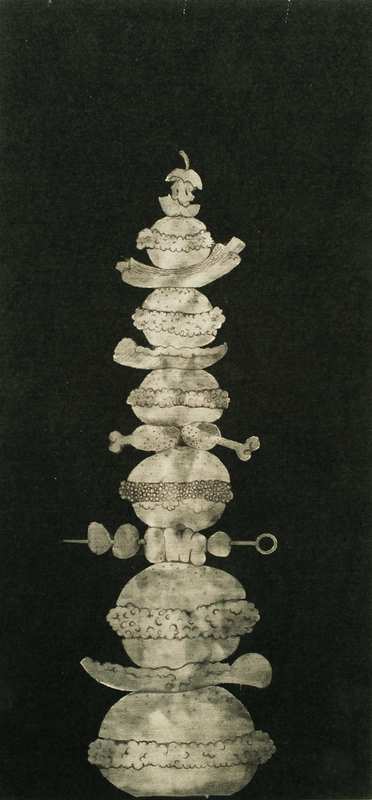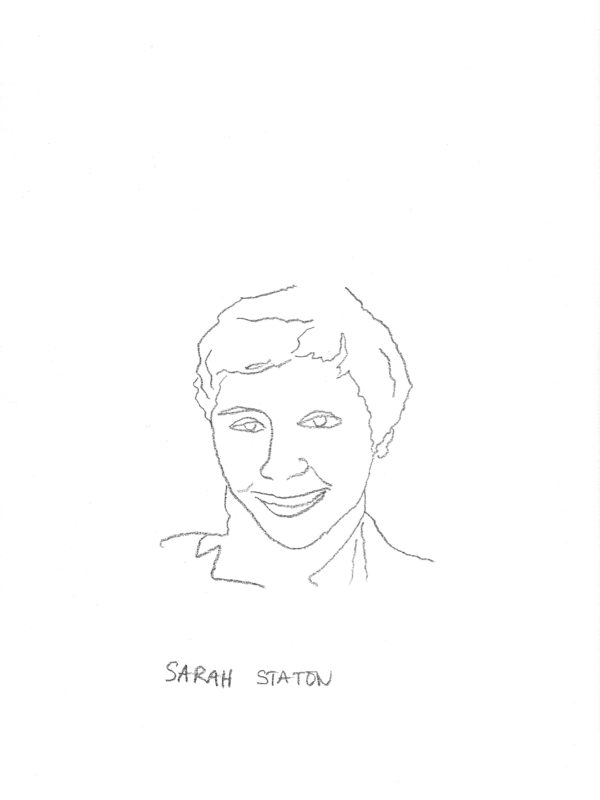Sarah Staton
- Artist Statement
- Curator Statement
- zingmagazine project
- Website
Artist Statement
Since 1999, I have been making paintings using a combination of bleach and denim. I have called these works “Anti-Paintings,” as the painting method involves the removal of color from the canvas, rather than the addition of color to the canvas.
I am quite “anti-Painting” in that the value of Painting (of the “White Male” kind) is quite over-determined in Western Culture.
The first “Anti-Painting” (1999) was called How the West Was Won and Lost. This has become the title for this group of works: the “Anti-Paintings” and accompanying sculptures. Some of these sculptures are made from bronze and nickel and include cotton plants, more buttons, and fast food.
The earlier pieces were made using blue denim, and later works using black denim. Blue denim has a wider cultural appeal, and black denim is badder. This “Anti-Painting,” Endless Column (Apple Core), is made from a combination of black denim, bleach, biro, and ink. The work is a two-dimensional representation of a column constructed from various fast foods that include burgers, ribs, pizza, chicken legs, kebab, more burgers, more pizza, which are topped with a well chewed apple.
The column is a totem of contemporary, global food culture. It takes its name from the Endless Column constructed by Brancusi, but shares none of the Modernist purity of those early 20th century productions. This Endless Column is about excess, a bastard creation of fast food industry, cynical capitalism, and redundant cultural production.
Curator Statement
Endless Column
Sarah Staton’s paintings, or “Anti Paintings,” as she calls them, are all made with a process of applying bleach to denim, and each is emblazoned with an icon, word, or phrase. The phrase, “How the West Has Won and Lost,” an image of a Macintosh raincoat button, the words “Krazy,” “Katz,” and “Harvest.” Her piece in the Dikeou Collection, Endless Column, features the image of a Dagwood sandwich, a “between the bun” totem pole of Fast Food, reminiscent of those Dagwood demanded from Blondie. While each of her paintings have a deliberate bleach spillage factor that is certainly a nod to Pollock, the glib and iconic words, phrases, and titles, recall word painters like Ed Ruscha and Christopher Wool, the Pop imagery of Claes Oldenburg, and most overtly in her title, the Modernist master sculptor, Brancusi. The “Anti-Paintings” often begin in gouache studies, as in Gertrude Stein, and some end up becoming full fledged installations, using the same cultural and semiotic alphabet of commercial segues we have come to expect to infiltrate our consciousness. In their execution and materials, Staton’s work utilizes the American “canvas” of jeans and text in an almost advertisement-like manner in order to represent a more universal landscape full of signifiers of youth, rock, urban, and country culture. Staton’s work cites our world cultures’ language and iconography from both high and low genres, with humor and formality that resonates in both our social history and arts. In other words, “there is no there, there” in the “two all beef patties.”


